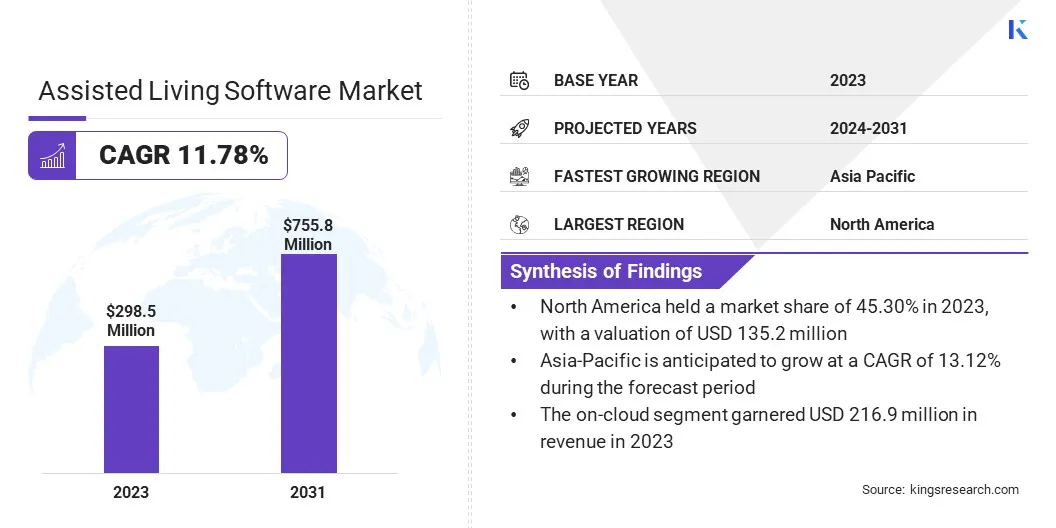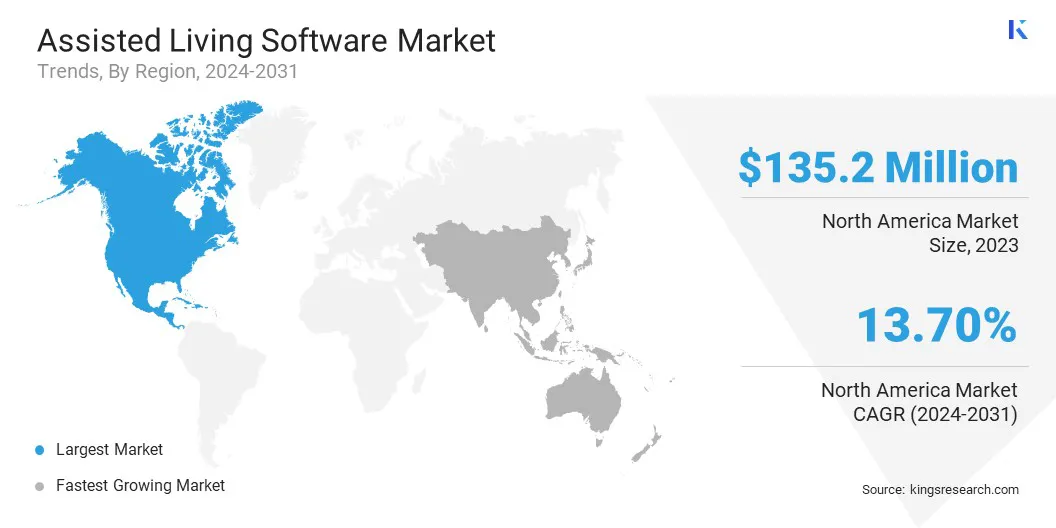Assisted Living Software Market Size
The global Assisted Living Software Market size was valued at USD 298.5 million in 2023 and is projected to grow from USD 332.3 million in 2024 to USD 755.8 million by 2031, exhibiting a CAGR of 11.78% during the forecast period.
The growth of the market is driven by the increasing elderly population, rising prevalence of chronic diseases, advancements in technology, regulatory requirements for improved care, and the notable shift toward cost-effective, efficient healthcare solutions.
In the scope of work, the report includes solutions offered by companies such as AL Advantage, Eldermark, Genexod Technologies LLC, MatrixCare, Medtelligent, Inc., Netsmart Technologies, Inc., Oracle, PointClickCare, Vitals Software, Yardi Systems, Inc., and others.
Technological advancements in software, particularly through integration with IoT and AI, significantly enhance patient care and operational efficiency. Regulatory mandates for improved patient care and safety further boost market growth. Furthermore, the rising shift toward value-based care and the need for streamlined administrative processes in assisted living facilities propel the adoption of these solutions.
- For instance, in March 2024, August Health introduced August Health Insights, a real-time system designed to enhance operational intelligence and advanced care in senior living. This system allows operators to address emerging risks and unmet resident care needs by providing real-time visibility into community data, detecting rising risk residents, and identifying operational risks. August Health Insights aimed to shift care from reactive to proactive by offering tools for improved operational and care management.
The assisted living software market encompasses solutions designed to enhance the operational efficiency and quality of care in assisted living facilities. These software solutions offer functionalities such as resident management, billing, medication management, and care planning.
North America holds a significant market share due to advanced healthcare infrastructure and high adoption of technology. Key market players include PointClickCare, Yardi Systems, and Eldermark, among others. The competitive landscape is marked by mergers, acquisitions, and collaborations aimed at expanding product portfolios and market reach.
Assisted living software refers to digital solutions used in assisted living facilities to manage various aspects of resident care and facility operations. These solutions facilitate efficient management of resident information, medication schedules, billing processes, and compliance with regulatory standards.
The software typically includes features for care planning, incident tracking, and reporting, designed to improve the quality of care and streamline administrative tasks. It supports caregivers and administrative staff by automating routine tasks and providing real-time access to critical information, thereby enhancing overall operational efficiency and improving resident satisfaction in assisted living environments.

Analyst’s Review
In the assisted living software market, key manufacturers are focusing on integrating advanced technologies such as AI and IoT to enhance their product offerings. Companies are introducing new solutions equipped with predictive analytics and improved data security to address the evolving needs of assisted living facilities.
- For instance, in May 2024, ECP, a provider of software for over 7,500 senior living and long-term care communities, introduced a suite of AI-powered tools for improved clinical outcomes and enhanced medication safety. These tools offers features for preventing duplicate medications, the over-dispensing of PRN drugs, and auto-identification of controlled substances. Additionally, they automate the updating of pharmacy orders and include vital drug information, thereby improving accuracy and compliance in medication administration.
Efforts are further directed toward creating user-friendly interfaces to facilitate adoption among staff and caregivers. Analysts recommend that stakeholders invest in continuous innovation and maintain a focus on user experience to mainatin competitiveness.
Additionally, fostering partnerships and collaborations help expand market reach and integrate diverse functionalities. Adapting to regulatory changes and addressing data privacy concerns are crucial for achieving long-term success in this dynamic market.
Assisted Living Software Market Growth Factors
The increasing elderly population is a significant factor fueling the growth of the assisted living software market. As the global population ages, there is a rising demand for assisted living facilities that provide high-quality care. Assisted living software enhances the operational efficiency and the quality of care in these facilities by automating tasks, managing resident information, and ensuring compliance with healthcare regulations.
The integration of advanced technologies such as AI and IoT in these solutions is further improving patient outcomes, making them essential in modern assisted living environments. This trend is contributing significantly to robust market growth, as more facilities adopt these technologies to meet the evolving needs of their residents.
A key challenge hampering the development of the market is the resistance to technological adoption observed in certain assisted living facilities. Many caregivers and administrative staff are accustomed to traditional methods and may find it difficult to transition to digital solutions.
Overcoming this challenge involves comprehensive training and support programs. By offering user-friendly interfaces and ensuring continuous training, software providers are gradually facilitating the transition process. Additionally, demonstrating the tangible benefits, such as improved efficiency and better patient outcomes, contributes significantly to gaining acceptance.
Providing excellent customer support and regularly updating the software based on user feedback leads to smoother adoption and long-term usage.
Assisted Living Software Industry Trends
The increasing integration of artificial intelligence (AI) and machine learning (ML) technologies is transforming the assisted living software market landscape. AI and ML are enhancing software capabilities by enabling predictive analytics, personalized care plans, and advanced data management. These technologies are allowing for more proactive and customized care, thereby improving resident outcomes and operational efficiency.
AI-driven tools are enhancing early detection of health issues, optimizing staffing schedules, and streamlining administrative tasks. As these technologies continue to advance, their integration into assisted living software is becoming increasingly prevalent, fostering innovation and transformation in the industry.
Another significant trend is the growing focus on data security and privacy in assisted living software. With the advancements in digital health solutions, protecting sensitive resident information is becoming increasingly critical. Software providers are investing heavily in advanced security measures, such as encryption, multi-factor authentication, and regular security audits, to safeguard data against breaches and unauthorized access.
Compliance with regulations such as HIPAA (Health Insurance Portability and Accountability Act) is resulting in enhancements in data security practices. As data privacy concerns continue to escalate, ensuring robust security features has emerged as a key trend influencing the development and adoption of assisted living software.
Segmentation Analysis
The global market is segmented based on deployment, application, and geography.
By Deployment
Based on deployment, the market is categorized into on-cloud and premises. The on-cloud segment led the assisted living software market in 2023, reaching a valuation of USD 216.9 million. This expansion is propelled by its scalability, cost-effectiveness, and ease of access.
Cloud-based solutions offer flexible storage options and reduce the need for extensive on-site infrastructure, making them particularly advantageous for assisted living facilities with varying sizes and needs.
Additionally, on-cloud solutions provide real-time data access and updates, which enhance operational efficiency and enable more effective care coordination. The increasing preference for remote access and data management capabilities is further fueling the growth of the on-cloud segment.
By Application
Based on application, the market is classified into cooking, personal care, housekeeping and laundry, monitoring medication, and others. The monitoring medication segment is poised to witness significant growth at a robust CAGR of 13.85% through the forecast period (2024-2031). This growth is bolstered by the increasing need for accurate medication management and adherence in assisted living facilities.
Monitoring medication software assists in tracking dosages, scheduling, and managing medication interactions, thus improving patient safety and enhancing care outcomes. The rising prevalence of chronic conditions and complex medication regimens is propelling the demand for advanced monitoring solutions.
Enhanced accuracy and efficiency in medication management are contributing to the rapid expansion of the segment.
Assisted Living Software Market Regional Analysis
Based on region, the global market is classified into North America, Europe, Asia Pacific, MEA, and Latin America.

North America assisted living software market accounted for a substantial share of around 45.30% in 2023, with a valuation of USD 135.2 million. This dominance is reinforced by the region's advanced healthcare infrastructure and rising adoption of technology. The regional market benefits from well-established assisted living facilities that increasingly implement software solutions to enhance operational efficiency and resident care.
The presence of major software vendors and continuous innovation in technology further supports regional market expansion. Additionally, stringent regulations and a strong focus on improving care standards boost the demand for advanced software solutions in this region, thereby solidifying the leading position of the regional market.
Asia-Pacific is poised to experience significant growth at a robust CAGR of 13.12% through the projection period. This rapid expansion is fostered by the region’s increasing elderly population and rising healthcare expenditures.
The expansion of infrastructure and growing awareness of the benefits of technology in assisted living are aiding this growth. The adoption of assisted living software is rapidly increasing as facilities seek to modernize and enhance care delivery.
Government initiatives and investments aimed at improving elderly care further support domestic market expansion. The rising demand for efficient management solutions and better care quality is establishing the Asia-Pacific region as one of the fastest-growing markets for assisted living software.
Competitive Landscape
The global assisted living software market report will provide valuable insight with an emphasis on the fragmented nature of the industry. Prominent players are focusing on several key business strategies such as partnerships, mergers and acquisitions, product innovations, and joint ventures to expand their product portfolio and increase their market shares across different regions.
Manufacturers are adopting a range of strategic initiatives, including investments in R&D activities, the establishment of new manufacturing facilities, and supply chain optimization, to strengthen their market standing.
List of Key Companies in Assisted Living Software Market
- AL Advantage
- Eldermark
- Genexod Technologies LLC
- MatrixCare
- Medtelligent, Inc.
- Netsmart Technologies, Inc.
- Oracle
- PointClickCare
- Vitals Software
- Yardi Systems, Inc.
Key Industry Developments
- November 2023 (Launch): Eldermark launched Eldermark NEXT, a next-generation software platform for senior living. The platform integrates insights from numerous customer communities and 30+ years of technology advancements to support senior living operations. It provides predictive and prescriptive analytics, mobile responsiveness, and intuitive business features. The platform enhances security, reliability, and scalability, and features a modern cloud-native architecture for quick implementation and ease of use.
- August 2023 (Partnership): Tata Consultancy Services (TCS) introduced the Seniors Lab digital pilot program in partnership with Sree Narayana Mission (SNM) Singapore. The initiative aimed to improve senior care by integrating IoT technologies to monitor movement, activity levels, and health parameters. The program sought to reduce healthcare costs and enhance seniors' comfort, safety, and independence. It built on the SHINESeniors initiative by adding features such as concierge services and emergency linkages.
The global assisted living software market is segmented as:
By Deployment
By Application
- Cooking
- Personal Care
- Housekeeping and Laundry
- Monitoring Medication
- Others
By Region
- North America
- Europe
- France
- U.K.
- Spain
- Germany
- Italy
- Russia
- Rest of Europe
- Asia-Pacific
- China
- Japan
- India
- South Korea
- Rest of Asia-Pacific
- Middle East & Africa
- GCC
- North Africa
- South Africa
- Rest of Middle East & Africa
- Latin America
- Brazil
- Argentina
- Rest of Latin America


